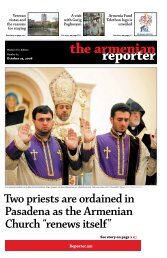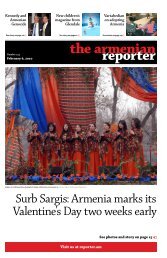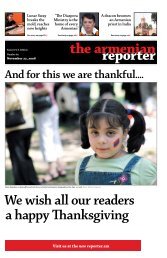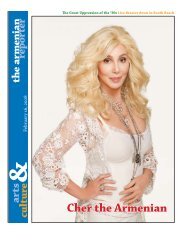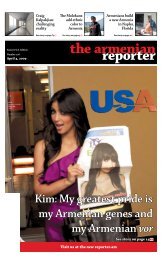Create successful ePaper yourself
Turn your PDF publications into a flip-book with our unique Google optimized e-Paper software.
Sumbat, an artist who captured village life in Iran Continued from page 12sites as Yosemite’s Half Domeseen from Inspiration Pointlose their reputation as startingpoints for all amateur artists andbecome merely beautiful places.It’s as if we are seeing them forthe first time when imbued withSumbat’s perfect color senseand depiction of light.But California is the end ofthe story; and even in Glendale,Sumbat’s favorite subjects were<strong>Armenia</strong>n villages; as the authordescribes, “In [Sumbat’s]mind the colors in no place wereas vibrant and delicate as in hisIsfahan.” Abrahamian describesSumbat’s Iranian subjects asthe “mesocosm”; he does notperform character studies, norbroad overviews, he takes amiddle view that conveys a placeas it is while he is seeing it. Onereviewer of his art describesthis as “The captured happinessof momentary encounters.”There is no specter of death inthese paintings. In a scene nearIsfahan a village is depicted setagainst a background of tallmountains. A man stands on acart loaded with hay while anotherman works on the ground.The frayed ends of the hay onthe cart are beside patches ofwind-blown dry grass. Sparsegreen leaves are seen on the fewtrees. The peaks of the mountainsseem to emanate the whitecloud patches that rise out ofthem. A foreground of layers ofearth and dirt road produce richshadows. The composition is insuch harmony with its partsthat the two men at work areas alive as the mountains, andshare the same attention in thescene. Of his work, Sumbat hassaid, “Inside I’m a happy personand I see happiness and brightnessin my scenes.”When using gouache, Sumbattested out colors on an oldnewspaper. One day he noticedshapes in the many stains ofcolor spread across the newspaper.He transformed the colorarray into an Iranian streetscene, embellishing the suggestionof forms he saw in the colorblots. He later dubbed this style“Sumbatism.” Although Sumbatwas not the first artist to mixprint and paint, Sumbatismsare quite unique. On canvassesof <strong>Armenia</strong>n and Farsi newspapersarise scenes of Iranian and<strong>Armenia</strong>n life; scenes of dancing,of making music and simplyof people walking throughtheir village. Yet in this contexteven a simple village scene isan exuberant celebration of life.The words of the world seem tocome alive, and every accidentalblot of paint is the nascent formof a life in the swell of activity.Sumbat would occasionallypaint portraits of family members,or of military officials for acommission; in the book thereare two self-portraits. In hisdepictions of himself there areno hints of ego or pomposity.He stands before his canvasseswith paintbrushes and a palettein his hand. His look is sincereand content. He knows who heis. One work that is much like aself-portrait is a still life of theartist’s tools. Assembled on theartist’s work table in this paintingare dishes of water, a cup ofbrushes and a pencil, a box ofjars of paint and a newspapercovered in smears of color whichobscure the name of the newspaper(although it is clear that itis “Asbarez”). One doesn’t needto see the artist’s face to recognizethat this is his identity andworld. Presented are the meansof artistic production, a catalogueof raw materials beforethe act of creation commences– or perhaps in the middle of anact of creation, because colorshave been tested on the newspaperand soon life will eruptspontaneously and overwhelmthe thoughts set down in printon the newspaper.The big jars of unmixed colorsin this still life are reminiscentof a later painting ofPersian carpet weavers in anIranian scene. The weavers areabsorbed in their work, weavingsmall pieces of yarn into abright and ornate carpet. Danglingabove their heads are bigballs of yarn in basic colors:bright yellow, green, red, blue,black, and white. The weavershave pulled what they needfrom these source colors, smallpieces of colored yarn sit inpiles around them, and withgreat skill and knowledge oftheir medium they composetheir masterpiece. The weaversare like the painter himself. It’sfrom the expert implementationof these raw colors thatthese great and quiet works ofart are produced. But the carpetweavers are only performingtheir everyday practice. All thecharacters depicted in Sumbat’spainting have a similar ease ofbeing and an unquestioningcontentment with their work,from young women carryingjugs of water home from thewell to villagers buying fruit ata market.The memories of these villagesinspired Sumbat all hislife. After living in Glendalefor 20 years, a copy of Asbareznewspaper, with its addresswritten in English, stillbrought forth from Sumbat’sbrush the colors, costumesand feelings of village life inIran. The estimated 10,000 ofSumbat’s paintings are currentlyscattered throughoutthe world. Since Sumbat’sworks were declared nationalSaghmosavank, 1992, watercolor, 56x42. Persian carpet weavers, 1997, watercolor, 45x30.treasures, the originals canno longer be exported fromIran for any reason; some ofthe earlier works were laboriouslyacquired from collectorsin Iran in order to representthis period of his art. Nevertheless,the book assemblesan impressive anthology thatcontains many examples of allhis evolving styles.Sumbat’s interest and skillin art has been passed down toBidhand villagenear Tehran,1977, watercolor,49x36.his family members. Der Kiureghian,when not engagedas a professor, spends time inLake Tahoe painting with watercolorsin some of the locationshis father painted, combiningwhat he’s learned fromhis father with his own style.Sumbat’s granddaughter, NairaDer Kiureghian, althoughnot a watercolorist, is also anaccomplished artist, and herwork in ceramics and other mediaexhibits the same wit andspontaneity that is seen in hergrandfather’s work. Der Kiureghianis presently workingon a full archive of Sumbat’smany works.The Life and Art of Sumbat wasprinted in Yerevan. It will beavailable through Sumbat.com,through Amazon.com, and in selectedbookstores, including AbrilBooks in Glendale, and ArtBridgebookstore-café in Yerevan. <strong>Armenia</strong>n <strong>Reporter</strong> Arts & Culture | December 19, 2009 13




